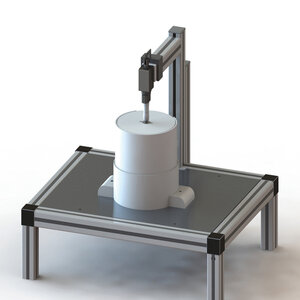proGAV® 2.0
The 500,000 Durability Test
We understand the gravity of the situation
The stress test in detail
... for those who want to know exactly
The goal is to prove the safety of the proGAV 2.0 adjustment and durability of the spring mechanism within the valve.
Our target was 500,000 clicks, a value chosen far beyond a realistic framework, which is represented in the following example:
If a patient presses once every minute on its valve, they would click for 8.333 hours or 347 days to reach 500,000.
Occasionally marketing, sales and doctors have questioned to the durability of the valve, if e.g. the patients themselves continuously press on the valve.
proGAV 2.0
Requirements for the testing
The brake mechanism of the proGAV 2.0 will be released 500,000 times through a targeted pressure on the detached valve.
The proGAV 2.0 must be fully functional before the test and after the test. This means the brake mechanism of the proGAV 2.0 must work before, during and after the test failure-free. Thus, the valve remains in the unpressed condition safe for adjustments of magnets of everyday life (up to 3 Tesla).
The test set-up is monitored over the entire duration of the video. Visability to the rotor movement is required. The valve cover is transparent so that a camera is able to monitor the movement of the rotor.
With the brake in the valve released, it is the aim that the proGAV 2.0 should be subjected to the magnetic force of the proGAV 2.0 adjustment tool and to be able to observe the rotation of the rotor. A software program counts the number of clicks.
Test stand (whole)
Test bench (cross-section)
Legend of the test assembly:
A: Magnetic actuator
B: Finger with flexible silicone steeve
C: proGAV 2.0 test valve with a transparent plexiglass base
D: Rotor with adjustment magnets
E: Video camera with light
F: Test bench frameG: Test rig casing
Start: 09/01/2016 at 9:34 AM
Ending: 09/02/2016 at 10.48 PM
Procedure:
Before starting the test, the valve was checked with the proGAV 2.0 measurement and adjustment tool.
The 3D-finger presses the valve diaphragm and triggers the braking mechanism. At the same time, the adjustment magnet system of the proGAV 2.0adjustment tool was rotated in the circle by an electric motor. The result is a constantly changing magnetic field in the valve.
During the test the function of the brake mechanism was verified several times. For this, the 3D-finger presses longer on the valve than in the regular frequency mode. If the rotor rotates in response to the moving magnets, the brake is released and the valve is adjustable. If the finger triggers pressure on the valve, then the rotor is fixed again and the valve is secured for an adjustment.
The camera on the valve inlet shows the entire test in addition to the rotor movement and also that the valve shows no signs of wear. The rotation of the rotor was intentional to the test structure to test the load for the valve.
The test is complete at 500,000 clicks.
After the test run, the valve is checked again via proGAV 2.0 measurement and adjustment tools.
The proGAV 2.0 was shown to be fully functional after 500,000 clicks on the valve.
- no effect on brake- no effect on rotor- valve was still able to be verified and adjusted
